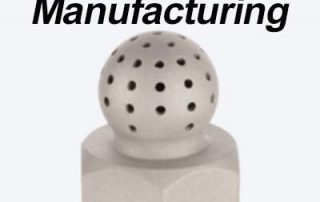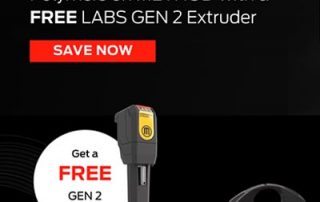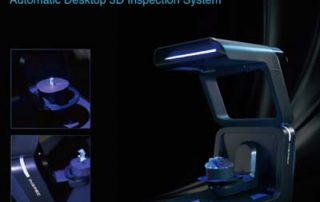Metrology Minute – Choosing a Scanner for Metrology
Choosing a scanner for metrology is a topic that comes up often when companies look to deploy non-contact inspection and question what criteria they should use when choosing a scanner for their company. We have covered this topic in detail at some recent Cimquest events but have had several customers ask more questions. Here are some of the highlights of these presentations. Accuracy vs Resolution Accuracy is the accuracy of the points acquired on the surface being scanned for inspection. An accuracy of +/-.001” would indicate that the maximum distance of the acquired (scanned) points is less than or equal to +/-.001”. Resolution is the scanner’s ability to capture fine detail. Please note that resolution is often referred to as ‘Point Spacing’ or Point cloud density. By definition, resolution is the shortest distance between any two points in the scan file. So if the very best resolution of a scanner is .010” that means the shortest distance between any two points in a scan can not be less than .010”. Keep in mind that ultimately small triangles are formed by connecting up three of these points to create a mesh. So another similar definition for resolution would be that no triangle leg in the [...]
3D Printing – No-Tooling and Faster to Market
What’s New in Tooling-Free Manufacturing? What could it mean to your business if you no longer needed to build jigs, fixtures, and molds? It means your engineers could design and produce end-use parts in as little as one day! If you need to print multiple versions of a part or make unique iterations binding jetting is the answer. By using binder jetting for metal 3D printing you will have the speed and accessibility to design and produce dozens of iterations in as little as a week. Once part designs are finalized, binder jetting technology makes it easy to go from printing a prototype or low volume bridge runs to produce thousands or even millions of parts. When there is no need for tooling or complex set-ups manufacturers can produce a part on one day and switch to a new part the next day with no delay in production. What are the Benefits? 3D Printing gives you the freedom to “design-for-additive-manufacturing” and eliminates the time and cost of hard tooling. DfAM provides you with the ability to make lightweight parts without sacrificing strength. And 3D printing also eases the burden on your shop floor. Engineers and designers no longer have to restrict part designs [...]
The Problem with the 3D Printing Industry
For the last 25 years, my company, Cimquest, has been representing 3D printers so it may be a bit surprising that you will find me pointing out what I feel is a very pressing issue in the industry. Not to get too political but many industries have been warped by the easy money policies of our government & Federal Reserve System. Under normal monetary conditions, startups would have to work very hard convincing investors to provide early capital to help jump-start their businesses. However, between the aggressive flow of money/credit into our financial markets and the overzealous hype in the 3D Printing space, it is too easy to attract big money too early. In an undistorted economy, most entrepreneurs (by definition) would have to take on greater than normal financial risks in order to organize and operate a business. However, with unprecedented quantitative easing in full swing, money flows to these innovators too easily and too fast, greatly reducing the upfront risks to the founders of the startups. I have watched with fascination as innovators figure out a slight improvement in an existing 3D printing technology only to make it their mission to create an entirely new company with all of the trimmings. [...]
Limited Time MakerBot Promo
With MakerBot METHOD you can now 3D print in Metals, Composites, and Polymers — all on one machine. For a limited time, unlock LABS materials such as BASF Ultrafuse 316L Stainless, Flexible SEBs, or PETG ESD with a FREE LABS GEN 2 Experimental Extruder when you purchase any METHOD 3D Printer. Limited time promo ends August 13, 2021. This promotion can be stacked with the 20% off METHOD and 25% off METHOD X promotion! Request a Quote Today
Autoscan Inspec from Shining 3D
The Autoscan Inspect structured light scanner has remarkable parameters at an extremely affordable price point. At just $13,200 complete, the Autoscan holds incredible accuracy of 10 microns (+/-.0004”) and has an equally incredible resolution of 50 microns (.0019”) making this an excellent choice for a customer in need of scanning small, precision geometry. The single-click calibration and scanning routines make this a simple scanner to use yet produce unbelievable results that today’s scanning professionals demand. Having a Field-Of-View of about a 4” cube, the scanner can handle a significant small part size range, making it a perfect solution for inspection, reverse engineering, or capturing models for 3D Printing applications. The built-in software takes care of scan alignment, global alignment, and scan merging, offering 100% complete part scans with virtually no human interaction required. Contact Cimquest today to find out more or to receive a demonstration of the Autoscan Inspec. More details by clicking below. More Details
Metrology Minute Cylindricity
Cylindricity – Similarities & Differences Between Related Callouts While this month’s segment is focused on Cylindricity we will also review several of the GD&T Callouts discussed previously (and a few not previously discussed but relevant to this month’s discussion) along with some of the similarities, as well as subtle differences between them. Cylindricity is a form of control tolerance that dictates both the roundness and center-axis straightness of a cylindrical part. If you consider the shaded cylinder below, the thin purple curve represents the “perfect cylinder” and the green represents the acceptable tolerance zone for that cylinder’s cylindricity callout. A sample callout is shown as well. Cylindricity is similar to Circularity (not discussed yet) however the latter relates to a single cross-section of the cylinder whereas Cylindricity refers to the entire length of the cylinder. This is very similar to the relationships of Flatness to Straightness where Flatness relates to the complete surface and Straightness is to a single cross-section, across the flat surface. You will also notice a similarity of Cylindricity to Total Runout (described in a previous Metrology Minute). Circularity and Runout are also very similar as they both deal with the form of curves and not surfaces. The most obvious [...]







